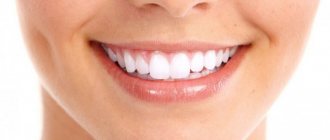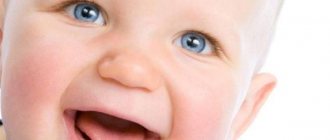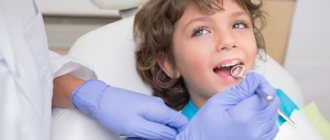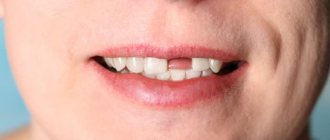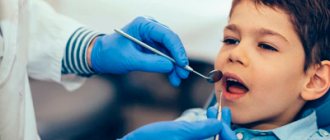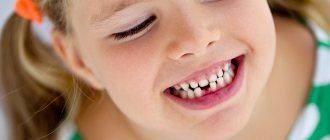- Why is it important to care for baby teeth?
- Which toothpaste to choose for a child
- How to choose a toothbrush for a child
- How to choose an electric brush for a child
- How to reduce the risk of developing caries and not give up sweets
- How to teach a child to brush their teeth
- Tips from a pediatric dentist: video
The age group from 3 to 8 years is characterized by the primary dentition, as well as the beginning of the mixed dentition - the appearance of the first permanent teeth. A child at this age learns to brush his teeth and can use an electric brush independently.
Today we will look at what oral care products you need to have at home for children of this age group. You will learn how to help a child with the habit of brushing their teeth daily, what to use to form healthy permanent teeth, and how to reduce the risk of developing caries without giving up sweets.
Why is it important to care for baby teeth?
There is a common misconception that caring for baby teeth is not necessary. After all, these teeth are not forever, and new “real” ones will soon grow to replace them. But in fact, you should start taking care of the health of permanent teeth long before they appear.
The health of future molars directly depends on the condition of the milk teeth, because their rudiments do not appear out of nowhere - they are already located under the milk teeth.
Temporary teeth influence the formation of the correct bite of permanent teeth. For example, if a baby tooth becomes inflamed, it may be delayed in falling out and spoil the growth of the permanent tooth, and if it is pulled out prematurely, the permanent tooth may grow crooked.
In addition, the early habit of caring for teeth, when they are still baby teeth, will ensure the child’s health for many years.
Treatment of caries in children
Milk teeth differ from permanent teeth in the smaller thickness of enamel and dentin. They have wide root canals, and the cavity is large, so in terms of the volume ratio of soft tissue to hard tissue, they also exceed permanent ones.
Since the enamel is thin, caries on baby teeth develops quickly. Without treatment, the carious process quickly destroys the crown and is transferred to soft tissues. The child develops pulpitis. This is one of the reasons why a child’s teeth need to be treated. In the early stages of development, carious lesions are almost invisible, but they can be diagnosed in time during a routine examination by a pediatric dentist.
For treatment we use modern filling materials. We can offer the child colored fillings. They differ from the usual filling materials that we use in filling the teeth of adult patients not only in color. Colored fillings have other features:
- The filling material is plastic and hardens quickly. This makes it easy to apply to the drilled cavity. Rapid hardening helps reduce treatment time, which is very important when performing dental procedures on a child.
- The fillings adhere tightly to the surfaces. Since the composite material is very flexible, it easily fills even small cavities. The risk of the filling falling out is minimal.
- The filling material is universal in use. It is suitable not only for filling carious cavities. It can also be used for other purposes, for example, to seal fissures to prevent caries.
- Simple monitoring of the condition of teeth after treatment. The fillings have different colors, so it is easy for parents to monitor their condition after treatment. Damage to the fillings is immediately noticeable, so you can take your child to the doctor in time.
Which toothpaste to choose for a child
The choice of toothpastes for children 3–8 years old is slightly wider than for toddlers - the child has already learned to spit out the toothpaste, so it may contain fluoride.
When choosing a toothpaste with fluoride, look at the safe concentration of this component - this is 500-900 ppm for children from 3 to 8 years old.
In addition to paste, you can use gels that strengthen the enamel. For example, Tooth Mousse - it helps to get rid of increased sensitivity and prevent the development of caries. There is no sugar in it, and the main components of the gel are calcium and phosphates, which are necessary for dental health. Remineralizing gel can be applied after brushing directly to the teeth or in special trays.
What should not be in baby toothpaste?
The fact that a child has already learned not to swallow toothpaste does not mean that he will not do this if the paste is especially tasty. For such cases, manufacturers have excluded harmful substances from the composition and found substitutes for them.
Children's toothpaste should not contain SLS and parabens. If the paste foams, it means it contains SLS, and it is better to discard it.
In addition, for proper care it is important that the baby toothpaste contains a minimum amount of abrasive substances. Soft abrasives are necessary for effectively cleaning teeth from plaque in adulthood, but there should be little of them in the composition of children's toothpaste. On the packaging, the degree of abrasiveness is indicated by the abbreviation RDA and for children ranges from 0 to 50.
What substances are useful in baby toothpastes?
Pay attention to the composition when choosing a new toothpaste for your child. You already know what should not be in the composition. Useful substances include fluorine and hydroxyapatite (or nanohydroxyapatite).
- Fluoride is an important substance for teeth, so toothpaste should contain a small amount of fluoride, which is usually indicated on the package. For children under 4 years old - 200 ppm, from 4 to 8 years old - 500 ppm.
- Hydroxyapatite is a modern alternative to fluorine. Synthetic hydroxyapatite is identical to the natural one that makes up enamel. It easily integrates into its crystal lattice and strengthens it, sealing microcracks and reducing sensitivity. In addition, hydroxyapatite eliminates caries at the white spot stage.
- Flavoring additives. This is not the most important and useful component - its choice depends on the preferences of the child himself. But it is important to know that flavors in children's toothpaste do not have to be of natural origin. Now special synthetic analogues have been developed that are completely safe if swallowed.
Toothpaste Dentissimo Junior Apple (from 6 years old)
Toothpaste ROCS (ROCS) Kids Berry Fantasy (from 4 to 7 years)
Toothpaste Brush-Baby Multifruit (from 3 to 6 years)
Biorepair Kids toothpaste with strawberry flavor (from 0 to 6 years)
Treatment of periodontitis in children
Periodontitis often develops against the background of untreated pulpitis. The inflammatory process develops in several stages and can take a long time. First, caries appears on the crown of the tooth. If left untreated, the infection affects soft tissue. If the tooth is not treated at this stage, the infection continues to spread. Following the pulp, the roots of the tooth are involved. Periodontitis develops.
At this stage, it is still possible to stop the inflammation. If this is not done, the infection spreads further and affects the buds of permanent teeth. This leads to dental problems during the formation of a permanent bite. In addition, any infection causes intoxication, which in itself is dangerous to the child’s health.
How to choose a toothbrush for a child
In this age group, both manual and electric brushes can be used. Brushes and attachments should be replaced every 2–3 months, as well as immediately after an acute infectious disease.
When choosing a suitable brush, pay attention to the following criteria.
- Age of the child. This is simple - pay attention to the age marking when choosing. For brushes recommended from 3 to 5 years, the length of the handle does not exceed 15 cm and the length of the head is 2 cm. From 5 to 8 years, the handle is up to 17 cm, the head is 2–2.5 cm.
- The stiffness of the bristles. Soft or ultra-soft bristles are suitable for children.
- Handle - should have anti-slip silicone or rubber inserts. Since fine motor skills are still developing, the brush should be such that the child can confidently hold it in his hands.
- Design. A brush with a bright design or with a favorite character will help get your child interested in brushing their teeth.
How to choose an electric brush for a child
From the age of 3 you can start using an electric brush. The advantage is that in children's lines you can find great opportunities for interactivity.
Some brands produce electric brushes with the ability to control brushing time via an app. The mobile application synchronizes with the brush and uses animated prompts to teach your child how to brush their teeth correctly. This helps maintain interest in the process.
For children aged 3 to 6–7 years, an electric brush with the softest bristles is suitable. It can be alternated with a regular brush. But remember: the use of an electric brush by a preschool child needs to be supervised.
Treatment of pulpitis in children
Pulpitis develops if caries is advanced. The infection spreads to the soft tissue and causes inflammation of the pulp. Parents often miss the onset of the development of pulpitis and bring their child to the doctor when complaints of pain already appear. Treatment takes place in several stages:
- First, the doctor opens the carious cavity and drills out the affected tissue. If you contact your dentist in a timely manner, the vitality of the pulp can be preserved. In advanced cases, the doctor may decide on the need to depulp the tooth.
- The cleaned cavity is treated with antiseptic drugs to avoid the risk of re-development of inflammation. Medicines are placed inside the cavity, after which it is closed with a temporary filling.
- When the inflammation is completely cured, the root canals are filled. At the last stage, a permanent filling is placed on the tooth.
When treatment for pulpitis is started on time for a child, in most cases it is possible to cope with the problem using conservative methods. In complicated cases, the doctor may decide on the need to remove the tooth.
How to reduce the risk of developing caries and not give up sweets
If your child has a sweet tooth or you are simply not ready to limit him, offer him an alternative - lollipops and candies with xylitol.
Xylitol or xylitol is found in the fibers of fruits, vegetables, birch bark and even mushrooms and is not a breeding ground for bacteria. When xylitol is added instead of sugar, it stops the growth and development of caries, since it is not absorbed by cariogenic bacteria, and they die.
Products containing xylitol can be consumed at any age. For children, 2-3 pieces of 100% xylitol chewing gum per day are enough to significantly reduce the risk of plaque and tooth decay.
In addition, chewing gum with xylitol will be useful for children who do not have the habit of actively chewing vegetables or meat. Chewing gum is useful as an additional exercise machine.
Lollipop Miradent XyliPOP (blueberry), 5 pcs.
Lollipops miradent Xylitol Drops mint
Chewing gum miradent Xylitol For Kids strawberry
How to teach a child to brush their teeth
For children aged 3–8 years, motivation when brushing their teeth is very important. Dentists recommend using different tips for this: for example, a timer or a calendar.
But before we look at specific products, let’s first talk about the principles that will help a child with proper brushing and develop a responsible attitude towards dental health.
- Follow a cleaning routine. It is best to teach your child to brush his teeth at the same time in the morning and evening.
- Children learn by example. This works better than any persuasion. At the very beginning, take your child with you to the bath and give him a brush - let him try to simply repeat after you. Over time, the game will become a habit, and he will remind you to brush your teeth.
- Give your child a choice. Let him choose his own toothpaste and brush, or better yet, a few to suit his mood. Variety every day will not let him get bored.
- Don't force, but motivate. Get your baby interested through games, a timer or a special calendar. With proper motivation, the child will not even notice how he will begin to follow all your recommendations with pleasure.
As for specific means of motivation, we will highlight three main ones.
- Timer. Agree with your child in advance that brushing your teeth will take exactly as long as the sand is poured in (doctors recommend at least 2 minutes). As a result, the baby will stop rushing and start watching the grains of sand. The timer can be either in the shape of an hourglass or built into an electric brush.
- Teeth brushing calendar. Hang it in the bathroom in a visible place so that the child can easily reach it. The teeth cleaning calendar can be of any type and design. For example, it may consist of 30 or 31 windows depicting the sun and moon. Each time, after brushing his teeth, the child will paint over or cover with a sticker the sun (in the morning) and the moon (in the evening).
- Means for detecting dental plaque . They allow you to quickly and easily monitor the effectiveness of teeth brushing in children, motivating them to take careful care. The products turn plaque blue, after which it can be easily removed with a toothbrush.
And don't forget to celebrate your baby's successes. Praise always motivates you to new achievements. For example, give your child figurines or stickers that he likes at the end of the week. The main thing is to agree with him about this in advance.
All the most necessary hygiene products for children from 3 to 8 years old are collected in our children's set No. 2. It includes:
- Children's toothbrush Curaprox Smart 7600;
- Biorepair toothpaste (Kids for 0–6 years or Junior for 7–14 years);
- Preventive foam Splat Junior with calcium and lactic enzymes;
- Anti-caries lozenge with xylitol Miradent Xylipop;
- Plaque indicating rinse Miradent Plaque Agent;
- Hourglass to control brushing time;
- Teeth cleaning calendar.
These are basic products that will help your child maintain healthy oral microflora and fight tooth decay.
Professional methods of prevention.
Fluoridation of enamel, application of special preparations to the surface of the teeth, resulting in the formation of a film from which fluoride ions penetrate the enamel and restore its structure.
Sealing of fissures - sealing with a filling material the chewing surface of the tooth, which is most susceptible to caries; the fissures are filled with a special sealant that protects the tooth surface from microbes and acid.
Professional oral hygiene is carried out using a mechanical brush and a special paste, which allows you to remove bacterial plaque that cannot be removed at home.
We must always remember that only through the joint efforts of the patient, his parents and doctors, can the child be kept healthy and the doctor’s visit enjoyable.
Make an appointment with a pediatric dentist by phone
Services and prices
Primary appointment (examination, consultation) with a pediatric dentist
1,600 rub.
Oral hygiene training
600 rub.
Removing soft plaque (1 tooth) using pastes
300 rub.
Removing hard dental plaque using an ultrasonic scaler
300 rub.
Fluoridation of teeth (1 tooth)
200 rub.
Fissure sealing (1 tooth)
1,200 rub.
Remineralizing therapy using a deep fluoridation system (1 tooth)
500 rub.
Drozdova Irina Viktorovna Head of department, pediatric dentist Doctor of the highest category Work experience: 36 years
Gnusova Vera Nikolaevna Pediatric dentist Work experience: 6 years
